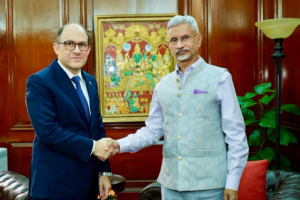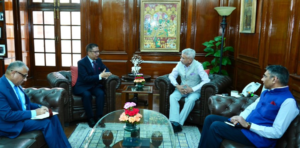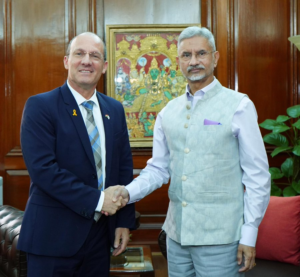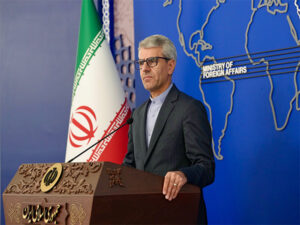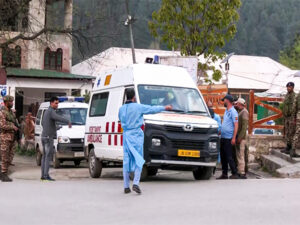Chandrayaan-3’s successful soft landing makes headlines across globe; hailed as massive moment for Indian space exploration
Washington/London, Aug 24 (PTI) Chandrayaan-3’s successful soft-landing on the Moon to propel India into an elite group of nations was lauded by leading foreign media outlets as a marvellous achievement and a massive moment for the country’s space exploration that has raised its profile as a spacefaring nation.
From The New York Times to BBC and The Guardian to The Washington Post, the historic event in India’s space programme on Wednesday made headlines across the globe.
Mainstream American newspapers, many of which had been sceptical of India’s space mission and sometimes even made fun of it through cartoons, noted the great Indian achievement.
“The Chandrayaan-3 mission makes India the first country to reach the lunar south polar region in one piece and adds to the achievements of the country’s homegrown space programme,” The New York Times reported.
The Washington Post wrote a couple of stories covering various perspectives and an opinion piece to celebrate this historic occasion.
“It is a marvellous achievement for India’s space programme – and symbolic of an important moment in geopolitics. For the successful landing came just days after a Russian mission to the same region went haywire and smashed into the lunar surface like a hammer coming down on the last nail in the coffin of Russia’s decline,” wrote David Von Drehle, Deputy Opinion Editor of the daily.
“‘India Is on the Moon’: Chandrayaan-3 Spacecraft Lands on Lunar South Pole,” wrote The Wall Street Journal.
The BBC headlined its article as ‘Chandrayaan-3: India makes historic landing near Moon’s south pole’.
“This is a massive moment for India – and it bumps them up the space superpower list,” Rebecca Morelle, BBC’s science editor wrote.
“Landing on the Moon is far from easy as Russia’s attempt this week highlighted and many missions have failed, including India’s first attempt,” she said.
“The mission could cement India’s status as a global superpower in space. Previously, only the United States, China and the former Soviet Union have completed soft landings on the lunar surface,” CNN said in the article ‘India becomes the fourth country ever to land a spacecraft on the moon’.
Chandrayaan-3’s landing site is also closer to the moon’s south pole than any other spacecraft in history has ventured. The South Pole region is considered an area of key scientific and strategic interest for spacefaring nations, as scientists believe the region to be home to water ice deposits, it said.
“Working alongside allies such as the United States and France, India is part of a second wave of emerging space powers. The country’s space programme has become one of the world’s busiest in its development of exploratory space technology,” it said.
India’s mission has taken on even greater significance since Russia’s failed Luna 25 landing attempt. With the success of Chandrayaan-3, India became the second country to land a spacecraft on the moon in the 21st century after China, which has put three landers on the lunar surface since 2013 including the first to touch down on the moon’s far side, CNN said.
India is only the fourth country to pull off a controlled landing on the surface, after the US, China and the former Soviet Union. That India chose one of the moon’s poles as its destination a tougher prospect than landing near the equator makes the success that much sweeter, Ian Sample, The Science Editor of The Guardian newspaper wrote in the article headlined ‘India’s south pole moon landing is big business for global space race’.
“Landing at the poles is much more difficult than landing at the equator. You’ve got to get into a polar orbit to release the lander, and nobody has done that before. The US hasn’t landed anything at the poles on the moon,” he said.
There is more to the achievement than the technical feat. The landing boosts the prestige of the Indian Space Research Organisation (ISRO) less than a week after a Russian probe spun out of control and crashed into the moon’s surface.
The landing raises India’s profile as a spacefaring nation at a crucial time. Like other countries, India has privatised its rocket launches. Through foreign investment, India plans to expand its share of the global launch market fivefold over the next decade. That ambition will be helped by India being seen as a low-cost provider of space launch services, the paper said.
“This is an exciting moment for Indian space exploration,” said Prof Andrew Coates at UCL’s Mullard space science laboratory.
“Following their earlier successful orbiters to the moon and Mars, this cements their position as one of the key spacefaring nations and is an impressive scientific and engineering achievement,” he said.
India has just fired the starting gun on the race for resources on the Moon,
Sarah Knapton, science editor, of The Telegraph wrote.
Nasa plans to send a rover to the south pole next year with US-based company Astrobotic Technology to measure water ahead of landing astronauts there in 2025 in the Artemis III mission.
China has also committed to sending astronauts there by the end of the decade, while Russia attempted a soft landing last week, which ended in failure.
So, it is somewhat surprising that it is relative newcomer India that got there first, giving the country an unexpected head start in the hunt for water and other resources, she said.
Calling it a huge triumph for Indian scientists and engineers, Tom Clarke, science and technology editor of Sky News, wrote by its engineers’ own admission, Chandrayaan-3 isn’t the most sophisticated spacecraft ever built, but they have achieved what other countries (most recently Russia) failed to do with an innovative, low-cost design.
Leaders in space like the USA, Europe and Japan are now looking to the private sector to explore and commercialise space. Sticking a moon landing is about the best pitch India’s high-tech sector could have wanted for its readiness to partner in international space projects, Sky News said in the article titled ‘India joins the exclusive club after successful moon landing – with innovative, low-cost spacecraft’.
India has become the first country to reach the moon’s uncharted south pole, prompting Prime Minister Narendra Modi to claim victory in a new global space race, The Independent newspaper wrote.
Deutsche Welle, the German state-owned media, commended India for being able to compete at the international level and part of the big league even in its space programme’.
Japanese daily Nikkei appreciated the mission by calling it a historic leap’.
The landing is also a win for Prime Minister Narendra Modi’s government which is showing off India as a leader in technology and an assertive global superpower, The Australian Broadcasting Corporation said.

